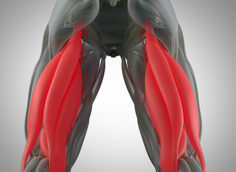Active Lymphatic Drainage for Recovery
This may be the most simple method to speed workout recovery, but it's very effective. As you train a muscle group, increased blood flow is siphoned to the area in order to continue to fuel the activity. This increased local blood flow also triggers a certain amount of fluid accumulation locally from the interstitial fluid balance, which is more commonly noticed as the prolonged pump effect of a tough workout.
While the lymphatic system is pivotal to human function, too much local lymph can limit the recovery process of local tissues and the system as a whole. Having control over the amount of local lymph is pivotal to expediting recovery. We can do this in a couple of ways.
First, we can use gravity to our advantage and use a systemic drain by elevating extremities (arms or legs) above the level of the heart in order to push lymphatic fluid back into central circulation.
On lower-body training days, this may be as simple as lying on your back and elevating your feet and legs (allowing a little knee bend) using a short plyo box.
For upper body training, just place the arms overhead in a relaxed position to enhance drainage. Do this 5-15 minutes after training.
A second simple mechanism to reduce lymphatic pooling is by using low-level active recovery activities such as walking and biking. The active muscle contractions place pressure on the passive veins and lymphatic vessels to push fluid back into central circulation. Walking slowly for a few minutes is as much as you need.





